How to stop the spread of COVID-19
Definition
Coronavirus disease 2019 (COVID-19) is a serious disease, mainly of the respiratory system, affecting many people around the globe. It can cause mild to severe illness and even death. COVID-19 spreads easily between people. Learn how to protect yourself and others from this illness.
Alternative Names
COVID-19 - Prevention; 2019 Novel Coronavirus - Prevention; SARS CoV 2 - Prevention
Information
HOW COVID-19 SPREADS
COVID-19 is an illness caused by infection with the SARS-CoV-2 virus. COVID-19 most commonly spreads between people with close contact (about 6 feet or 2 meters). When someone with the illness coughs, sneezes, sings, talks, or breathes, droplets carrying the virus spray into the air. You can catch the illness if you breathe in these droplets.
In some instances, COVID-19 may spread through the air and infect people who are more than 6 feet away. Small droplets and particles can remain in the air for minutes to hours. This is called airborne (or aerosol) transmission, and it occurs mainly in enclosed spaces with poor ventilation. However, it is more common for COVID-19 to spread through close contact.
Less often, the illness can spread if you touch a surface with the virus on it, and then touch your eyes, nose, mouth, or face. But this is not thought to be the main way the virus spreads.
The risk of spreading COVID-19 is higher when you interact closely with others who are not in your household for longer periods of time.
HOW TO PROTECT YOURSELF AND OTHERS
You can spread COVID-19 before you show symptoms. Some people with the illness never have symptoms, but can still spread the disease. However, there are ways to protect yourself and others from getting COVID-19. These tips can help you and others stay safe:
- Get a COVID-19 vaccine, including the booster. Being vaccinated helps protect you from getting and spreading COVID-19. Being vaccinated can also help protect you from serious illness if you do get the virus.
- Make sure children ages 6 months and older get the COVID-19 vaccine. Getting children and teens vaccinated helps prevent them from spreading COVID-19 to older relatives and young siblings and friends who can't or don't get the vaccine. It also helps protect children and teens from serious illness.
- If you are vaccinated, and in an area where COVID-19 is spreading, you should always wear a face mask or respirator that fits well without gaps when you are indoors in public.
- If you are not fully vaccinated, or if you have a weakened immune system, you should always wear a face mask indoors in public regardless of how active COVID-19 is in your community.
- Avoid crowded areas where the virus can more easily spread. Keep a distance between yourself and others.
- Check the public health department website for information on COVID-19 in your area and follow local guidelines.
- Avoid poorly ventilated indoor spaces and crowded areas, even if you are vaccinated. If you are indoors, open windows to help bring in outdoor air, if possible. Spending time outdoors or in well-ventilated spaces can help reduce your exposure to respiratory droplets.
- COVID-19 tests can help prevent the spread to others. You can use COVID-19 self-tests at home and get quick results whether or not you have been vaccinated or have symptoms.
- Wash your hands many times a day with soap and running water for at least 20 seconds. Do this before eating or preparing food, after using the toilet, and after coughing, sneezing, or blowing your nose. Use an alcohol-based hand sanitizer (at least 60% alcohol) if soap and water are not available.
- Cover your mouth and nose with a tissue or your sleeve (not your hands) when coughing or sneezing. Droplets that are released when a person sneezes or coughs are infectious. Throw away the tissue after use.
- Avoid touching your face, eyes, nose, and mouth with unwashed hands.
- Do not share personal items such as cups, eating utensils, towels, or bedding. Wash anything you have used in soap and water.
- Know the symptoms of COVID-19. If you develop any symptoms, call your health care provider.
- Know steps to take if you are exposed to someone with COVID-19.
HOME ISOLATION
If you have COVID-19 or have symptoms of it, you must isolate yourself at home and avoid contact with other people, both inside and outside your home, to avoid spreading the illness. This is called home isolation.
- As much as possible, stay in a specific room and away from others in your home. Use a separate bathroom if you can. Do not leave your home except to get medical care.
- Do not travel while sick. Do not use public transportation or taxis.
- Keep track of your symptoms. You may receive instructions on how to check and report your symptoms.
- Use a well-fitted face mask or respirator that fits well without gaps when you see your health care provider and anytime other people are in the same room with you. If you can't wear a mask, for example, due to breathing problems, people in your home should wear a mask if they need to be in the same room with you.
- Follow the same hygiene practices everyone should follow: cover coughs and sneezes, wash your hands, don't touch your face, don't share personal items, and clean high-touch areas in the home.
You should remain at home, avoid contact with people, and follow the guidance of your provider and local health department about when to stop home isolation.
For the most up-to-date news and information about COVID-19, you can visit the following websites:
Centers for Disease Control and Prevention website. Coronavirus Disease 2019 (COVID-19) - www.cdc.gov/coronavirus/2019-ncov/index.html.
World Health Organization website. Coronavirus Disease 2019 (COVID-19) Pandemic - www.who.int/emergencies/diseases/novel-coronavirus-2019.
Gallery
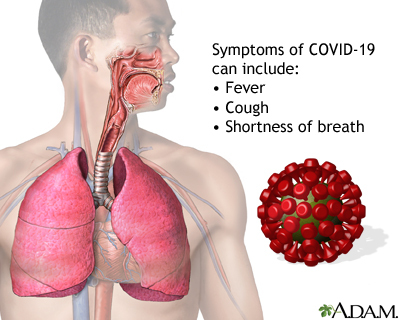
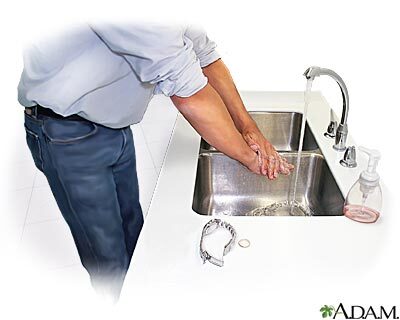
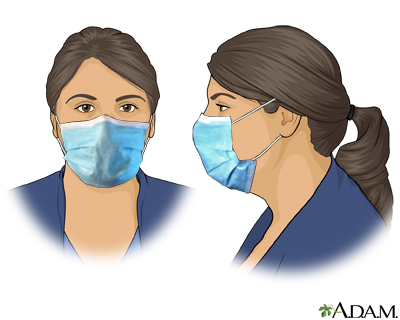
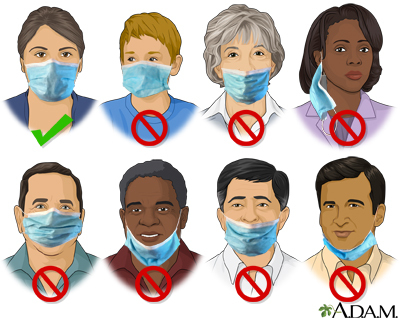
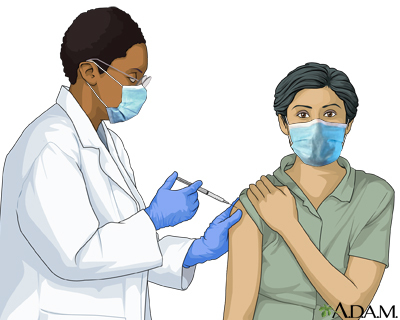
References
Centers for Disease Control and Prevention website. COVID-19: How COVID-19 spreads. www.cdc.gov/coronavirus/2019-ncov/prevent-getting-sick/how-covid-spreads.html. Updated August 11, 2022. Accessed January 27, 2023.
Centers for Disease Control and Prevention website. COVID-19: How to protect yourself and others. www.cdc.gov/coronavirus/2019-ncov/prevent-getting-sick/prevention.html. Updated October 19, 2022. Accessed January 27, 2023.
Centers for Disease Control and Prevention website. COVID-19: Masks. www.cdc.gov/coronavirus/2019-ncov/prevent-getting-sick/masks.html. Updated August 12, 2021. Accessed January 27, 2023.
Centers for Disease Control and Prevention website. COVID-19: Use and care of masks. www.cdc.gov/coronavirus/2019-ncov/prevent-getting-sick/about-face-coverings.html. Updated September 9, 2022. Accessed January 27, 2023.
Centers for Disease Control and Prevention website. Stay up to date with COVID-19 vaccines including boosters. www.cdc.gov/coronavirus/2019-ncov/vaccines/stay-up-to-date.html. Updated January 25, 2023. Accessed January 27, 2023.